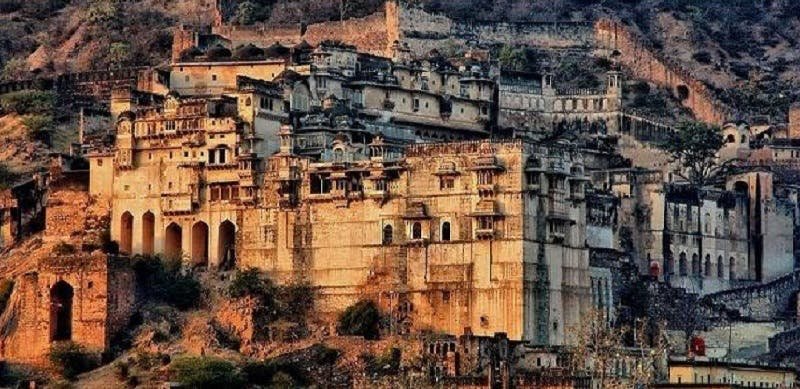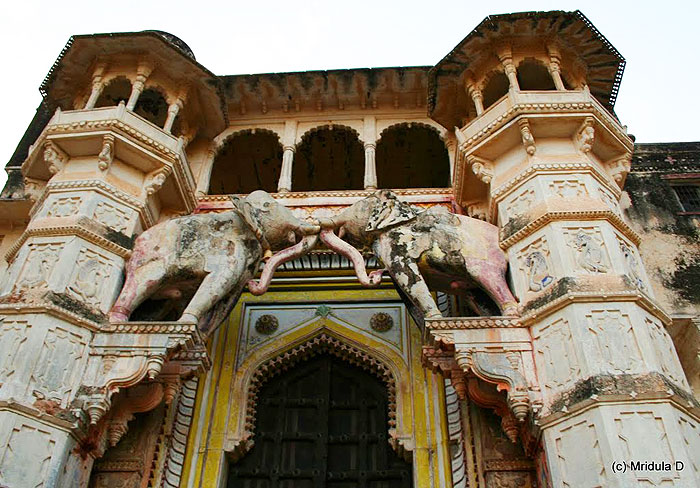Bundi
is a town in the Hadoti region of Rajasthan state in northwest India. It is of
particular architectural note for its ornate forts, palaces, and stepwell
reservoirs known as baoris. It is the administrative headquarters of Bundi
District. Bundi has many temples, so it is called "Chhoti Kashi".

Sukh Mahal
Sukh Mahal, a small, two-storied palace was a summer retreat of past rulers. Today, it is quite famous for being the place where Kipling wrote ‘Kim’. Many credit the palace as a having played muse to the renowned novel. In fact, part of a movie based on the novel was even shot here.
Kshar Bag
Located near the Chhatra Vilas Garden, Kshar Bag, sometimes known as Saar Bagh, houses the memorial cenotaphs of the royal family of the Bundi state. It is located on the Shikar Burgh Jait Sagar Road.
Raniji ki Baori
Raniji ki Baori, also known as 'Queen's Stepwell', is a famous stepwell built in 1699 by Rani Nathavati Ji, the younger queen of the ruling king Rao Raja Anirudh Singh of Bundi. This multi-storied stepwell displays excellent carvings of Gajraj with his trunk turned inwards, giving the impression of having drunk from the baori on its pillars. Its high arched gate gives it an inviting appearance.

Nagar Sagar Kund
Located outside the Chauhan Gate, the Nagar Sagar Kund, a set of twin step wells, was constructed to provide water during times of famine.
Taragarh Fort
Built in 1345, Taragarh is one of the most impressive structures in Bundi. While it may be a bit ramshackle and strewn with overgrown vegetation, the palace grounds are a great place for a leisurely stroll. With its curved roofs topping pavilions, excess of temple columns and elephant and lotus motifs, the palace is a tribute to Rajput style.

84 Pillared Cenotaph
As the name suggests, the 84 Pillared Cenotaph is a structure supported by 84 columns. Commissioned by Rao Anirudh, the Maharaja of Bundi, this cenotaph is a tribute to his beloved wet nurse, Deva, who he loved dearly. A popular tourist attraction, this impressive structure is decorated with carvings of deer, elephants and apsaras.
Nawal Sagar Lake
Nawal Sagar Lake is an artificial lake that is a major tourist attraction and can even be seen from the Taragarh Fort. There is a half-submerged temple dedicated to Lord Varun Dev in its centre. What makes the lake unique is that one can see the reflection of nearby palaces and forts in its waters.
Garh Palace Bundi
The Garh Palace in Bundi is counted among the largest palaces in India, even if it is a little less known. Inside, the palace is a collection a number of palaces that were built by different rulers over the span of 3 centuries. Garh Palace is known for its Rajput architecture, which is easily noticeable in the jharokhas and pillars, many of which sport elephant carvings. Some of the famous palaces here include Chhatra Mahal, Phool Mahal and Badal Mahal, but one of the most famous ones has to be the Chitrashala, which has a fascinating pavilion and gallery of miniature murals. The palace is open to visitors from 8.00 am in the morning till 5.00 pm in the evening. There is a small entry fee that has to be paid, and one has the option to hire a guide who can take you through the stories and history of this beautiful palace.
Hathi Pole
The steep climb to the Garh Palace in Bundi ends at two main gates that are used for entrance. Of these two gates, the most popular is the Hathi Pole. This gate is a huge architectural feat that evokes a sense of grandeur. The gate has two elephants depicting blowing bugles, and was commissioned by Rao Ratan Singh. Marking the entrance of the Garh Palace, the Hathi Pole forms a major point of attraction in Bundi.

Ramgarh Vishdhari Sanctuary
Ramgarh Vishdhari Wildlife Sanctuary is located 45 kilometres from Bundi on the Bundi-Nainwa road. Covering an area of 252 sq. km., this sanctuary is home to a variety of flora and fauna. Established in 1982, it forms a buffer for Ranthambore National Park. The best time to visit is between September and May.
No comments:
Post a Comment